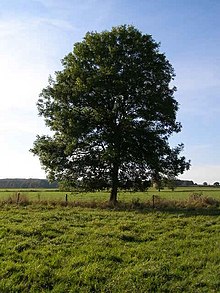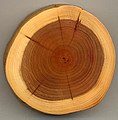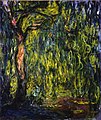Portal:Trees
The Trees Portal

In botany, a tree is a perennial plant with an elongated stem, or trunk, usually supporting branches and leaves. In some usages, the definition of a tree may be narrower, including only woody plants with secondary growth, plants that are usable as lumber or plants above a specified height. In wider definitions, the taller palms, tree ferns, bananas, and bamboos are also trees.
Trees are not a monophyletic taxonomic group but consist of a wide variety of plant species that have independently evolved a trunk and branches as a way to tower above other plants to compete for sunlight. The majority of tree species are angiosperms or hardwoods; of the rest, many are gymnosperms or softwoods. Trees tend to be long-lived, some reaching several thousand years old. Trees have been in existence for 370 million years. It is estimated that there are around three trillion mature trees in the world.
A tree typically has many secondary branches supported clear of the ground by the trunk, which typically contains woody tissue for strength, and vascular tissue to carry materials from one part of the tree to another. For most trees it is surrounded by a layer of bark which serves as a protective barrier. Below the ground, the roots branch and spread out widely; they serve to anchor the tree and extract moisture and nutrients from the soil. Above ground, the branches divide into smaller branches and shoots. The shoots typically bear leaves, which capture light energy and convert it into sugars by photosynthesis, providing the food for the tree's growth and development.
Trees usually reproduce using seeds. Flowers and fruit may be present, but some trees, such as conifers, instead have pollen cones and seed cones. Palms, bananas, and bamboos also produce seeds, but tree ferns produce spores instead.
Trees play a significant role in reducing erosion and moderating the climate. They remove carbon dioxide from the atmosphere and store large quantities of carbon in their tissues. Trees and forests provide a habitat for many species of animals and plants. Tropical rainforests are among the most biodiverse habitats in the world. Trees provide shade and shelter, timber for construction, fuel for cooking and heating, and fruit for food as well as having many other uses. In much of the world, forests are shrinking as trees are cleared to increase the amount of land available for agriculture. Because of their longevity and usefulness, trees have always been revered, with sacred groves in various cultures, and they play a role in many of the world's mythologies. (Full article...)

Sabinaria magnifica is a species of palm tree and the only member of the genus Sabinaria. Native to the Darién Gap on the border between Colombia and Panama, it grows from 1 to 6 metres (3 ft 3 in to 19 ft 8 in) tall with large, deeply-divided leaf blades. It has been described as "striking", "spectacular" and "beautiful" by taxonomists.
Although known by local mule drivers, it was first collected in April 2013 by Saúl Hoyos, and described scientifically by Colombian palm experts Gloria Galeano and Rodrigo Bernal who named the genus Sabinaria after their daughter. Despite being locally abundant, the limited range occupied by the species makes it vulnerable to habitat destruction. (Full article...)Did you know? -
- ... that veneration of the Amla tree (pictured), in particular on Amalaka Ekadashi, is due to the belief that the god Vishnu resides in and near the tree?
- ... that the future of the tropical tree Milicia regia for timber production is threatened by a gall fly, Phytolyma lata?
- ... that the churchyard of All Saints Church, Ulcombe in England contains a yew tree claimed to be more than 2,000 years old?
- ... that seeds of the extinct tree Eucommia eocenica have been found with latex covered fossils?
- ... that the fruits of the Lecythis ampla tree resemble little wooden pots with lids?
- ... that fossilized seeds of the extinct tree Eucommia montana are found from British Columbia to Colorado?
- ... that the Australian tree Agathis atropurpurea is known as the black kauri or the blue kauri because of the colour of its bark?
Selected article -
Paubrasilia echinata is a species of flowering plant in the legume family, Fabaceae, that is endemic to the Atlantic Forest of Brazil. It is a Brazilian timber tree commonly known as Pernambuco wood or brazilwood (Portuguese: pau-de-pernambuco, pau-brasil; Tupi: ybyrapytanga) and is the national tree of Brazil. This plant has a dense, orange-red heartwood that takes a high shine, and it is the premier wood used for making bows for stringed instruments. The wood also yields a historically important red dye called brazilin, which oxidizes to brazilein.
The name pau-brasil was applied to certain species of the genus Caesalpinia in the medieval period, and was given its original scientific name Caesalpinia echinata in 1785 by Jean-Baptiste Lamarck. More recent taxonomic studies have suggested that it merits recognition as a separate genus, and it was thus renamed Paubrasilia echinata in 2016. The Latin specific epithet of echinata refers to hedgehog, from echinus, and describes the thorns which cover all parts of the tree (including the fruits). (Full article...)General images
Selected lists
Subcategories
Related portals
Associated Wikimedia
The following Wikimedia Foundation sister projects provide more on this subject:
-
Commons
Free media repository -
Wikibooks
Free textbooks and manuals -
Wikidata
Free knowledge base -
Wikinews
Free-content news -
Wikiquote
Collection of quotations -
Wikisource
Free-content library -
Wikispecies
Directory of species -
Wikiversity
Free learning tools -
Wiktionary
Dictionary and thesaurus














































































